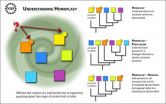(Press-News.org) Cambridge, MA- Adding particles to liquids to make currents visible is a common practice in the study of fluid mechanics. The approach was adopted and perfected by artist Paul Matisse in sculptures he calls Kalliroscopes. Matisse's glass-enclosed liquid sculptures contain an object whose movement through the liquid creates whorls that can be seen only because elongated particles trailing the object align with the direction of the current; light reflects off the particles, making the current visible to the viewer.
Researchers at MIT recently demonstrated that this same phenomenon is responsible for the swirling patterns scientists typically see when they agitate a flask containing microbes in water; many microbes are themselves elongated particles that make the whorls visible. More importantly, they say this phenomenon occurs in the ocean when elongated microbes caught in a current align horizontally with the ocean surface, affecting how much light goes into the ocean and how much bounces off as backscatter. Because many ocean microbes, like large phytoplankton, have either an elongated shape or live in communities of long chains, this orientation to ocean currents could have a substantial effect on ocean light — which in turn influences photosynthesis and phytoplankton growth rates — as well as on satellite readings of light backscatter used to inform climate models or assess algal blooms.
In a quiescent ocean, phytoplankton are randomly oriented and light filters through easily. This random arrangement is usually assumed in models of light propagation in the ocean and in satellite readings. But fluid flow can change things.
"Even small shear rates can increase backscattering from blooms of large phytoplankton by more than 30 percent," said Roman Stocker, Professor of Civil and Environmental Engineering at MIT and lead author on a paper about this work. "This implies that fluid flow, which is typically neglected in models of marine optics, may exert an important control on light propagation, influencing the rates of carbon fixation and how we estimate these rates via remote sensing."
Another consideration is microbial size. Very small microbes (less than 1 micrometer in diameter) don't align with the ocean current no matter what their shape. "These very small things don't align because they are too vigorously kicked around by water molecules in an effect called Brownian motion," said Stocker, who studies the biomechanics of the movements of ocean microbes, often in his own micro-version of a Kalliroscope called microfluidics. He recreates an ocean environment in microfluidic devices about the size of a stick of gum and uses videomicroscopy to trace and record the microbes' movements in response to food and current.
In this case, however, the research methodology was observation, followed by mathematical modeling (much of which was handled by graduate student Marcos, who created a model that coupled fluid mechanics with optics), and subsequent experimentation carried out by graduate students Mitul Luhar and William Durham using a tabletop-sized device.
But the impetus for the research was an observation of swirling microbes in a flask of water and a question posed by Justin Seymour, a former postdoctoral fellow at MIT. "Justin walked up to me with a flask of microbes in water, shook it, and asked me what the swirls were," said Stocker. "Now we know."
In addition to Seymour, who is now a research fellow at the University of Technology Sydney, other co-authors on the paper are Marcos, Luhar and Durham; Professor James Mitchell of Flinders University in Adelaide, Australia; and Professor Andreas Macke of the Leibniz Institute for Tropospheric Research in Germany.
Next steps: The researchers plan to test this mechanism in the field in a local environment suitable for experimentation, most likely a nearby lake.
INFORMATION:
Funding: Funding was provided by grants from the National Science Foundation and the Australian Research Council and by a Hayashi Grant from MIT's International Science and Technology Initiatives Program.
Source: "Microbial alignment in flow changes ocean light climate," by Marcos, Justin Seymour, Mitul Luhar, William Durham, James Mitchell, Andreas Macke and Roman Stocker, in PNAS Early Edition online Feb. 21, 2011.
Written by: Denise Brehm, Civil and Environmental Engineering, MIT
END
With the genetics of so many organisms that have different traits yet to study, and with the techniques for gathering full sets of genetic information from organisms rapidly evolving, the "forest" of evolution can be easily lost to the "trees" of each individual case and detail.
A review paper published this week in Science by David Wake, Marvalee Wake and Chelsea Specht, all currently National Science Foundation grantees, suggests that studying examples of homoplasy can help scientists analyze the overwhelming deluge of genetic data and information that is currently ...
Montreal, February 24, 2011 – The interventional cardiology team at the Montreal Heart Institute (MHI) recently began patient enrolment for a new device, the Neovasc ReducerTM, designed to treat patients suffering from refractory angina. The treatment method is a first in North America and is being conducted as part of an international study, the COSIRA trial. This innovative treatment is promising for thousands of Canadians disabled by refractory angina and who lack alternatives for relieving their symptoms and improving their quality of life.
Developed in Canada by ...
A strong link between victimization experiences and substance abuse has been discovered by researchers at the University of Illinois at Chicago.
The correlation is especially prevalent among gays, lesbians and bisexuals -- more so than in heterosexuals, says Tonda Hughes, professor and interim head of health systems science in the UIC College of Nursing. Hughes is lead author of the study, published in the journal Addiction.
Researchers compared victimization experiences of unwanted sexual activity, neglect, physical violence, and assault with a weapon, across four ...
ARLINGTON, Va. - One Sailor's request to replace humming fluorescent bulbs with a quiet alternative inspired the Office of Naval Research (ONR) to create the Solid State Lighting (SSL) project, currently being evaluated aboard several ships and submarines across the U.S. Navy.
A product of ONR's TechSolutions program, SSL is one of several rapid-response technologies created using recommendations and suggestions from Navy and Marine Corps personnel. (Watch TechSolutions products in action via YouTube.)
The SSL project introduced the energy-saving, nonhazardous LED ...
Age alters memory. But in what ways, and why? These questions comprise a vast puzzle for neurologists and psychologists. A new study looked at one puzzle piece: how older and younger adults encode and recall distracting, or irrelevant, information. The results, published in Psychological Science, a journal of the Association of Psychological Science, can help scientists better understand memory and aging.
"Our world contains so much information; we don't always know which is relevant and which is irrelevant," said Nigel Gopie, who cowrote the study with Fergus I.M. Craik ...
Researchers at the University of California, San Diego School of Medicine and Rady Children’s Hospital-San Diego say an evolutionary gene mutation that occurred in humans millions of years ago and our subsequent inability to produce a specific kind of sialic acid molecule appears to make people more vulnerable to developing type 2 diabetes, especially if they’re overweight.
The findings are published in the Feb. 24 online edition of The FASEB Journal, a publication of the Federation of American Societies of Experimental Biology.
Corresponding study author, Jane ...
Wheat growers in the Southwest have a better idea about how to adjust to climate change in the decades ahead, thanks to U.S. Department of Agriculture (USDA) scientists in Arizona.
Researchers with the USDA's Agricultural Research Service (ARS) installed infrared heaters in experimental wheat fields at the agency's Arid-Land Agricultural Research Center in Maricopa, Ariz., to simulate growing conditions expected by 2050. ARS is USDA's principal intramural scientific research agency, and this research supports the USDA priority of responding to climate change.
Wheat ...
COLUMBUS, Ohio – New research shows that a less-toxic combination of a targeted immune-based drug and a chemotherapy drug can produce long-term remissions in some chronic lymphocytic leukemia patients. And it does so without increasing the risk of later therapy-related myelodysplastic syndrome and acute myeloid leukemia, which can often occur with a three-drug combination used to treat these patients.
The multi-institutional study, led by researchers at the Ohio State University Comprehensive Cancer Center – Arthur G. James Cancer Hospital and Richard J. Solove Research ...
Spraying malaria-transmitting mosquitoes with a genetically modified fungus can kill the malaria parasite without harming the mosquito, potentially reducing malaria transmission to humans, according to a new study published in the journal Science. Funded by the National Institute of Allergy and Infectious Diseases (NIAID), part of the National Institutes of Health, the study was led by Raymond J. St. Leger, Ph.D., of the University of Maryland, College Park.
An estimated 225 million malaria cases occur worldwide annually, resulting in about 781,000 deaths each year, ...
MOAB, Utah — Drier conditions projected to result from climate change in the Southwest will likely reduce perennial vegetation cover and result in increased dust storm activity in the future, according to a new study by scientists with the U.S. Geological Survey and the University of California, Los Angeles.
The research team examined climate, vegetation and soil measurements collected over a 20-year period in Arches and Canyonlands National Parks in southeastern Utah. Long-term data indicated that perennial vegetation in grasslands and some shrublands declined with temperature ...

